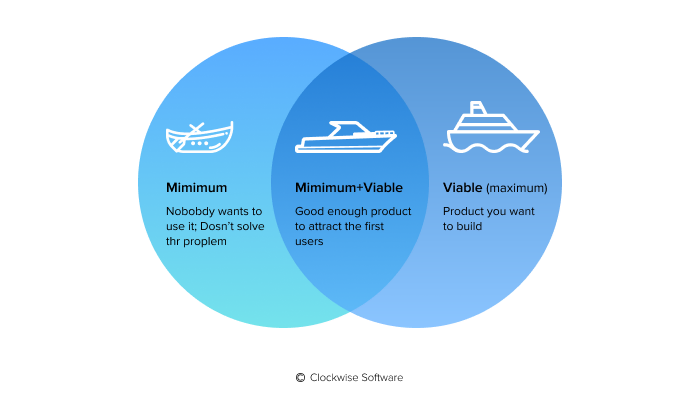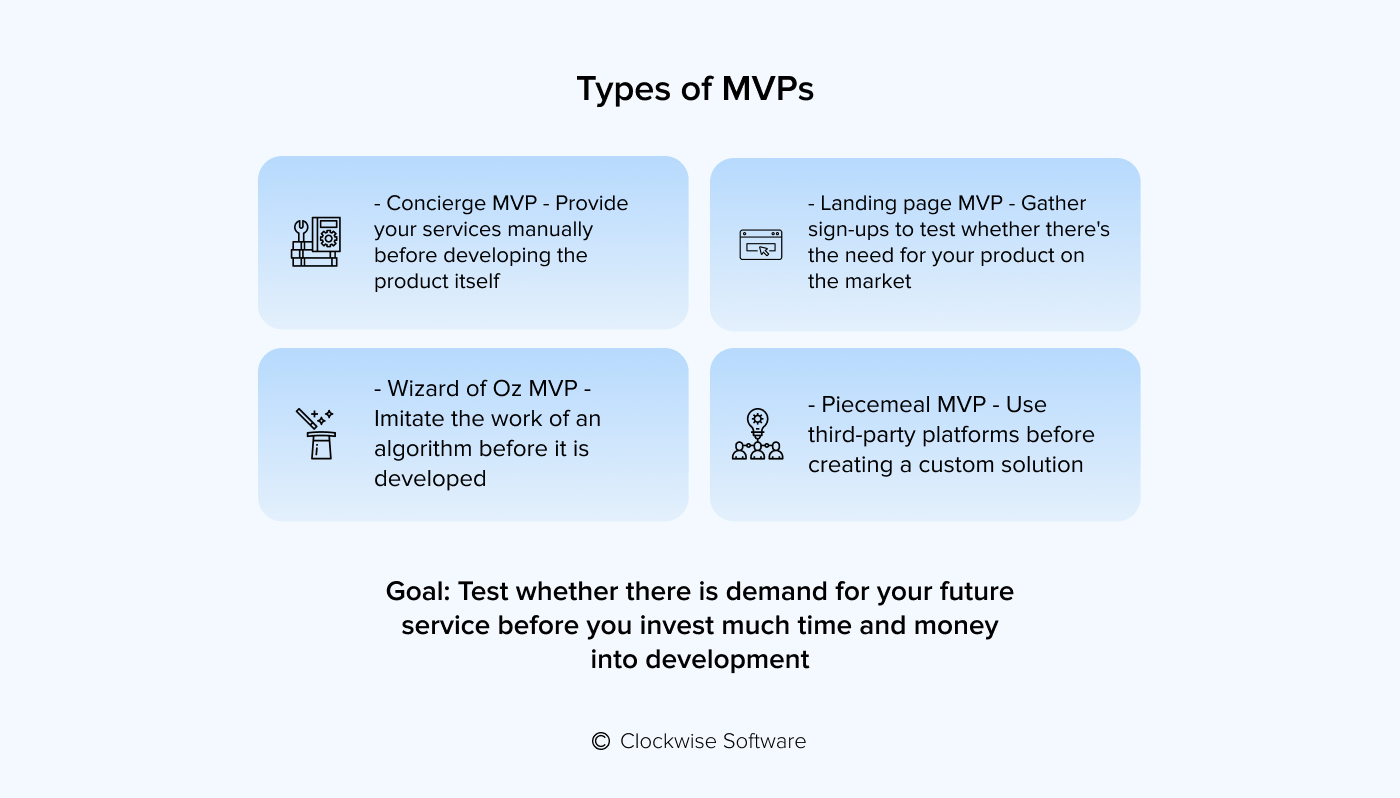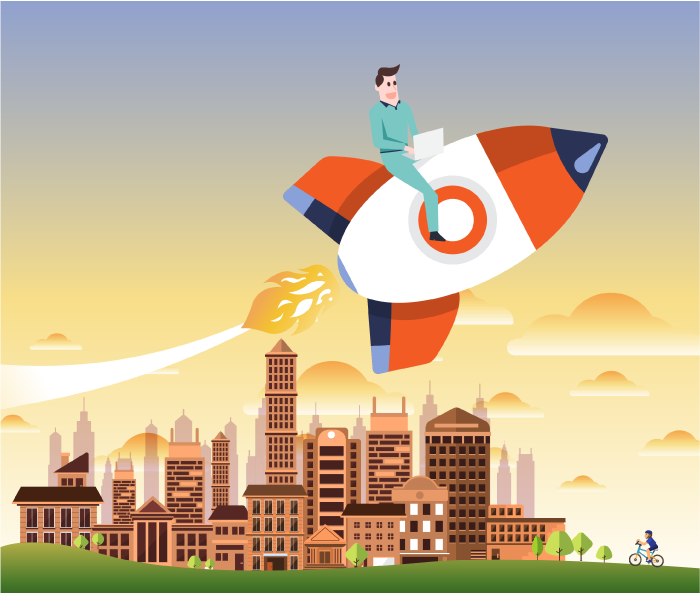What we do
Services
Experts in
Creating a company from scratch is for the brave. Even if you win the hearts of investors and your brilliant business idea has been approved by dozens of friends, there are so many things that could go wrong.
According to statistics, one-third of startup owners say they’ve started their businesses with less than $5,000 and without any confidence they would turn it into a success.
To mitigate the risk of failing in your first year of founding a business, create an MVP first. In this article, we’re going into detail about what an MVP is when it comes to startups, what types you can implement, and why the MVP startup phase is important.

An MVP is like a seat belt. If you’re driving a car, you probably understand that you might get into an accident. But if you wear a seat belt, there’s a bigger chance you’ll survive the accident.
Metaphors aside, a minimum viable product (MVP) is an initial version of a product or service built for early adopters. Basically, it offers enough functionality to enable your users to test the product and understand the value behind it. Plus, it’s a perfect testing ground for developers and founders, demonstrating what should be improved based on user feedback.

There are three key things about MVP software product development process that you should get right:

In the history of Shark Tank, an American reality TV series where you can present your business idea to an investor, almost 900 startup founders did their pitches and around 56 percent of those made successful deals with investors. You can find more detailed stats about ten years of Shark Tank pitches here.
If you’ve ever watched the show, you know that most of the contestants don’t have a complete product on hand. What they have, though, is a draft – an initial version of what they want to drive investments for. This is one of the good reasons why it’s important to build an MVP.
A product with the basic functionality helps you understand whether it can potentially drive profits. You can use it for pitching, collecting feedback from friends and family, or testing with early adopters.
A business doesn’t always start with an MVP. There are at least three alternative ways to choose from: launching a product without preliminary testing, going with a prototype, or running a POC test. Before you dive into development, make sure you understand what you are opting for or whether you need to use more than one.

In contrast to MVP, prototype is the initial version of a product that’s never released. You may use it for internal tech and security testing, in-house presentations, etc. If you’ve heard about the Theranos scheme, you know why going with a prototype can cause lots of trouble. Because the startup has never really demonstrated their blood-testing machine to anyone except for the in-house teams, they managed to fool a huge number of investors and earn $9 billion, advertising a product that never actually existed.
If you mean well and want to see how people react to your product, you need feedback. This is only possible with an MVP.
Therefore, prototyping is a good idea if you need to come up with multiple drafts or test several versions before building your MVP.
Another MVP alternative is called proof-of-concept (POC), a practicality test that is applied to a project to see how it performs. Running POCs is a useful practice if you want to test separate aspects (concepts) instead of the whole product. In developer’s language, POC is about fixing bugs as you go, enabling correct functionality from the get-go. Going back to Theranos, the startup has never run a POC. This becomes obvious if you dive into the functioning of their lab prototypes: multiple machines malfunctioned, some didn’t work at all, and it took way more blood to run a test than the company had initially intended.
Concluding the Theranos case, you might say that it’s reasonable to use as many testing techniques as you can – from prototype to MVP. While it makes sense for an innovative product like a portable lab, it’s not necessarily going to be the case for you. The goal is to fit your project into a lean methodology, so that it covers planning, MVP, and implementation. You can start drafting ideas through prototypes, develop the first version with regular POCs, and test user feedback with an MVP. Or maybe a well-crafted MVP is all it takes.

There are several types of startup MVPs you can embrace, depending on your project objectives:
Concierge MVP. As the name suggests, a concierge MVP is there to assist your company in gathering specific data about your target audience to align your project with what people actually need. In this case, you usually don’t have a technical realization of your idea yet, so you do most of the work manually.
Use case: Zappos is a good example of how you can utilize this type of MVP – validating a product fit without actually developing a product. Thus, the founder of Zappos used to buy shoes from a local store whenever anyone ordered from the Zappos website, based on an agreement with the store owner.
Wizard of Oz MVP. Before you automate something, you do it manually – this is the easiest way to explain the Oz MVP. The strategy comes in handy if you want to test complicated functionality before you invest into it. Basically, you have to fake the algorithms to make users feel they're using a technically advanced product you haven’t developed yet.
Use case: Let’s say you want to build an automated platform where HRs could be matched with candidates, based on sophisticated matching algorithms. At the MVP stage, you can simply have your team do all the matching based on profile research.
Landing page MVP. In lean methodology, promoting your product through a landing page is a popular practice. This is the best option if you only need to validate an idea and don’t have a prototype yet.
Use case: As an example, Buffer gained traction by generating sign-ups on its MVP landing page. Building an MVP for a non-existent service not only helped prove the value of the Buffer idea, but also gave the startup their first client base. You can read more about Buffer’s experience here.
Piecemeal MVP. If you use third-party platforms and tools to create your MVP, it’s called piecemeal. The most common example would be using an external messaging platform for testing before you build a native one.
Use case: Groupon used an existing WordPress blog to post their deals instead of developing their own platform. This helped them maximize on marketing while investing minimum money into the service at the initial stages.
Sometimes you know right from the start what MVP strategy resonates with your project. If you are starting to tap into a product/market fit, we recommend choosing low-risk MVP models like Landing page or Piecemeal MVP. In case you have a clear idea you want to validate, Concierge and Oz will make much more sense. However, in 90 percent of cases it’s about experience and a product manager’s gut feeling. The good thing is, there are many ways to “prove your gut feeling” such as analyzing successful MVP examples. Here’s a nice online course on designing and running MVP experiments you might want to check out.

A scalable product is a result of planning, doing, testing, and redoing. In other words, unless you have a perfect understanding of what your target audience wants, you have to collect feedback before releasing the final version. This simple idea lies at the heart of lean startup development. But as many startup owners know, the devil is in the details. What’s the right type of MVP? Where do you learn the steps to launch an MVP? How do you prioritize the features that go into an MVP? While we won’t be able to answer all your questions, here are some vital tips you can embrace right now:
The hardest thing about MVP is killing your darlings – you have to include minimum functionality and weed out the rest.
For startup owners, it’s often too painful. This means there should be a regulated process that would allow for selecting the features that make the most sense, in a methodical and cold-blooded way. Here’s how we recommend approaching features prioritizing:
When you build an MVP, you don’t have to follow a well-trodden path. The goal of creating an initial version of a product is to see whether you can sell it in the long run. In some cases, bringing viable features into an MVP just won’t work. For instance, if the goal of a business is to sell an experience rather than a service, viability is not something to focus on.
In his Medium article on MVP practices, the author compares MVP to MDP – minimum delightful product, the concept first mentioned by Adam Berrey. According to it, you might choose quality, design, or the so-called product “gestalt” (the completeness of a product) over viability if it fits your intention. There’s a very simple explanation for that: Sometimes people buy a product only because it makes them feel delighted.
TunnelBear VPN is a good example of a product that requires MDP, rather than MVP. If you look at the reviews of the product, you’ll notice that along with the positive feedback on its secure logging and performance, there’s one thing that stands out: a fun approach. The VPN puts a bear on your Mac – an animated character that makes you fall in love with the flow.
To prolong the effect of testing, you can actually become an MVP startup. That’s how Spotify works, using an iterative approach that combines the elements of Agile, Lean methodology, and MVP iterations. The goal is to bring improvements into the product on a regular basis, based on user feedback and trends. If you’re open to making regular adjustments to your product, this is the strategy you might opt for.
Most of the products developed at Clockwise Software adhere to this approach. We believe that constant iterations based on real user feedback help to keep the product at the top!

So if you’re wondering what is MVP in startup, there’s no answer to the question. Basically, the first version of your product is whatever you want to validate, be it viable functionality, mobile app design, quality, or anything else. To see the practical side of an MVP, take a look at some of the examples:
Startup owners often share the same two problems: 1) they don’t have a team to build and test an MVP; 2) they fail at prioritizing, because they feel bad about excluding product features. There’s a solution, though. If you’re looking for an expert opinion in terms of MVP application development, or if you’ve never done MVP before, we highly recommend relying on outsourced software development.
